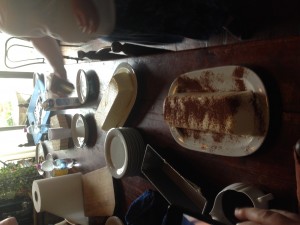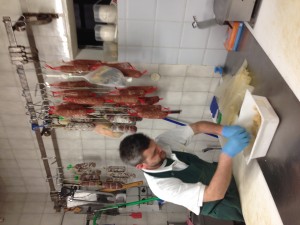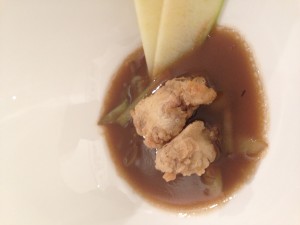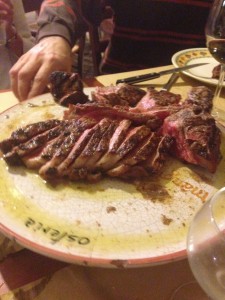Introduction and History
Food is not something that people often associate with the idea of simplicity. In our American culture, we often prize complexity in our food and having many flavors combined into one dish. We need bitter and sweet; salty and savory in order to be satisfied with our dish. Even when we are served a meal with several separate items on it, we often combine them and thus combine the flavors of the food in order to create an almost chaotic experience in our mouths. This was something that I had greatly enjoyed about my culture, but since I have been in Italy, I began to appreciate the way that Italians approach food. Italian cooking is completely different from my native cooking, and in my opinion, surpasses it on many levels. After experiencing this cooking for several weeks, I wanted to understand why this was so. What is the main feature of Italian cooking that defines its character? What about it makes it so different from my native cuisine? The answer is surprising; the quality of the Italian cuisine comes from its simplicity. Having spent several weeks in Italy, it has become evident that this is true through experiencing a variety of dishes and comparing them to American counterparts. It is clear through the ingredients, preparation, and taste of the dishes that simplicity is the key to the cuisine’s success, and I will delve into these areas to show how this is true. Food is a more integrated part of Italian culture, and the people behind the meals have spent their lives dedicated to learning, understanding, and striving to stay true to the recipes that have been in their culture for centuries.
One of the main reasons why Italian cuisine is extremely simple is because when these recipes were created, it was out of necessity. Many dishes came from people who were in poverty who had to be creative with the few ingredients that they had available to them. We made several of these dishes during class with Lele and Elissa, such as cecina and spaghetti alla olive. What started out as meals of necessity turned into delicious meals that have become staples in the Italian cuisine.
Ingredients
The start of any meal is the ingredients, and Italian chefs use only the best. Almost everything that goes into their dishes they either grow themselves or get from another part of Italy, and this is a major point of emphasis for the chefs. They want to have the freshest ingredients possible for their creations and will not accept food that is not of high quality. An example of this is what we have seen from our cooking classes with Lele and Elisa. Particularly with the vegetarian meal that we made, we primarily used food that was picked from either their garden or from a garden of a friend. They stressed how important this was, and it was clear in the final product how it affected the quality of what we ate. You do not rely on ingredients coming in from halfway across the globe that have lost their freshness and quality, and do not represent where you come from. You grow what you can and use it in the most effective and tasty way that you can think. Additionally, there are often not many ingredients that go into Italian dishes. They prize using fewer ingredients and try to bring out the best flavors from what they have. An example of this is the burger that we had at Dario’s butchery. It was simply just his high quality ground beef with bread crumbs on the outside and was not even served on a bun. This is in contrast with a burger that I had in America which had a bun, cheese, fried macaroni and cheese balls, bacon, French fries, onion rings, and mozzarella sticks. While this may seem ridiculous (and it is to an extent), this is considered to be a better burger than many others because of the variety of toppings that it had. However, the simple burger from Dario’s was of a much higher quality and the meat alone had more flavor than any amount of toppings could have given another burger. This is the Italian idea of simplicity in terms of ingredients and it is a major component in terms of both the quality and the identity of the dish.
Preparation
The next part of creating a dish is in the preparation. Instead of using extremely complex machinery and cooking equipment to combine their ingredients, the Italian chefs that I have seen use simple tools and, for example, do not even always use an automatic beater even when it will be faster. They value the process more than cutting corners or taking the faster alternative in order to make sure that everything is made properly. This is rooted in the different perception of time and doing things in a certain amount of time that is present in Italian society. They are more relaxed and understand that there will always be time to get everything done which allows them to not have to rush when they are preparing meals. They are able to minimize mistakes and, along with their fresh ingredients, improve flavors. One place where this was extremely evident was at Andrea Falaschi’s butchery, particularly in the sausage that he gave us. They did not use a ridiculous or mechanized system to prepare their meats; they simply took their time and did everything by hand. This had a profound effect on the final product, as it was of very high quality and was the best sausage that I have ever eaten. Preparation is key to Italian cuisine, and their simple and effective methods lead to high quality dishes.
Taste and Experiencing the Dish
Ingredients and preparation combine for the most important feature of the dish: the taste. Instead of going for a large mix of flavors, many Italian dishes attempt to get only one flavor from their creations. Italians believe that even if you have two flavors in one dish, then it is too much. An example of this is the steak that we had at Mangiando Mangiando. The flavor was incredible, but most of it came from just the meat, instead of coming from a complex mix of steak sauces and pre-made seasonings. The flavor of the steak was not very complex, but it was extremely deep and powerful. This is very typical of the meals that we have eaten here, and another example of where is this stressed is at our cooking lessons with Lele and Elissa. Through these lessons, we could see the culmination of using the proper ingredients and preparation to make something that tastes truly amazing, and we could appreciate the simplicity in this process.
While the actual food may be very simple, there is some complexity when it comes to the menu and how the food is presented. There are often more courses than in American meals that contain less food and aim to give a burst of flavor and texture rather than attempting to fill the eater up with just one dish. In just one sitting, one can experience a wide variety of flavors and textures, such as with the meal that we had at L’Imbuto. Everything that we had was very simply made and did not contain many ingredients, but there was always a strong and interesting flavor. Whether it was the cow brain or the risotto, none of the food was too complex, but the combination of dishes that we had helped to create a wide variety of tastes during the meal.
Conclusion
Through my various experiences on this trip, it was clear that simplicity is an integral part of the Italian cuisine. This philosophy along with their knowledge of the food allows them to create unique and delicious dishes that are vastly different from the dishes in the American cuisine. The ingredients, preparation and taste of the dishes in Italy are all rooted in their simplicity, and combine to create incredible meals that everyone should experience.





